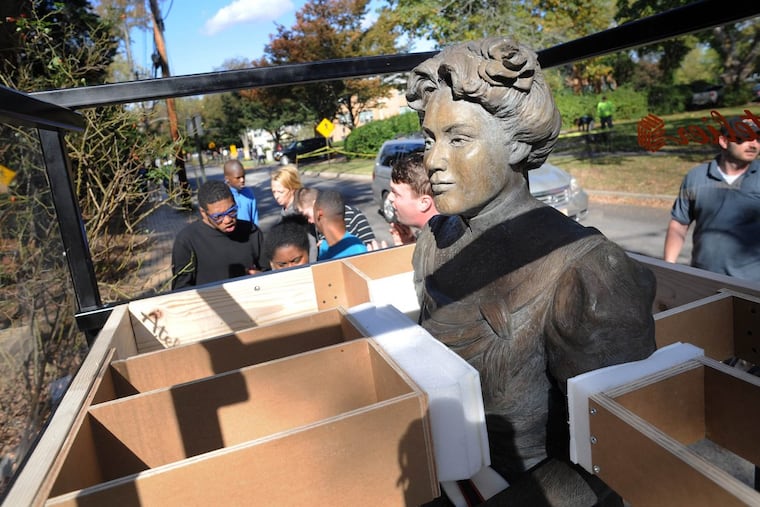As Bancroft leaves Haddonfield, the borough and the school look ahead
Margaret Bancroft's will is a testament to her pioneering vision of special education - and her foresight about her school's future needs

Margaret Bancroft, the teacher who pretty much invented special education, sought to ensure that the Haddonfield school she founded in 1883 would continue its mission long after her death.
"Reading her words in her will … it's almost like she knew at some point it was going to have to be rebuilt, and bigger," Bancroft CEO and president Toni Pergolin says.
Bancroft's leader since 2005, Pergolin is overseeing the school's transition from its obsolete Kings Highway campus to a new, $75 million complex on 80 acres of open land near I-295 and Route 38 in Mount Laurel. The Haddonfield facilities are set to close Dec. 20; Jan. 3 will be the first day of classes on the new campus.
"We have room to grow there," adds Pergolin. "This move is for the next 100 years."
The residential and day school's departure from its birthplace — a move symbolized by a celebration last Thursday as a beloved bronze sculpture of Margaret Bancroft was loaded on a flatbed — promises to be a dramatic change for 225 students and 500 staff, as well as for the borough of 11,500.
"It's somewhat bittersweet," Mayor Neal Rochford says. "Bancroft has for so long been a part of the Haddonfield family."
Says former Mayor Jack Tarditi: "Most people in town have embraced Bancroft. They're a premier organization that helps people have as much quality of life as possible. And they've been very involved in the town."
For more than a decade, as Bancroft began to publicly explore whether to stay or go, the future of the 19 woodsy acres the school occupies along Kings Highway and Cooper River Park have been a focus of what could be described as a slow-motion civic brawl.
A contentious referendum that would have enabled the Haddonfield school district to acquire the property for expansion of its high school facilities was defeated in 2013, followed by a furious effort to stop an addiction rehab center from being built there. Haddonfield purchased the property for $12.2 million in 2016.
On Wednesday, the borough planning board is set to review a redevelopment plan that calls for demolishing most of Bancroft's nondescript campus and developing 80 "age-targeted," and up to a dozen affordable, townhouses on an 8.2-acre portion of the site east of Hopkins Lane.
The school's impressive Lullworth Hall mansion, along with its carriage house and grounds, would be preserved. So would nearly five acres of passive open space abutting the townhouses, while an additional 4.6 acres west of Hopkins Lane and adjacent to the high school would be set aside for recreational use.
Rochford says the plan isn't perfect but does strike a balance between preservation of open space and historic assets, while offering "a new type of housing stock" for current residents looking to downsize and stay in the walkable downtown area.
But not everyone in town is thrilled with the plan for the borough's single largest remaining tract of developable land. Tarditi, for one, says he is concerned about renderings that depict a formidable-looking row of townhouses along Kings Highway.
"I don't want to see over-development there," longtime borough resident Kim Custer says. "What Margaret Bancroft did was amazing, and I don't want to see that history forgotten."
For Bancroft, sadness about leaving is tempered by excitement about what the new campus will offer. Amenities will include walking trails, an activity center with a pool and basketball court, vocational training kitchens and retail vocational training facilities (sponsored by ShopRite and Wawa), and space for visiting parents to spend private time with their children.
Children and adults served by Bancroft, which also includes a dozen other outpatient or residential facilities and programs in South Jersey, tend to be more severely disabled — many, with autism — than the typical students of Margaret Bancroft's day. Pergolin notes that less disabled youngsters often can be accommodated in their local school districts.
That was not an option for Joe and Laura Atkinson's daughter. Now 24, Casey Atkinson would become so frustrated by communication difficulties that she would sometimes become violent, or try to injure herself. She entered a residential program at Bancroft in 2000 and is doing well.
"Bancroft has enabled her to communicate," says Laura, who along with her husband and a younger son moved to Haddonfield five years ago from Bucks County. "They've given her a voice. And she has some independence."
Providing developmentally disabled youngsters with educational and vocational tools was at the core of Margaret Bancroft's mission. At a time when most kids like them were locked away in institutions or kept out of sight by their families, she established a "training school" that offered intensive, one-on-one assistance to help special children learn.
"I have devoted my life to the education and care of [these] of my fellow beings … in the belief that infinite patience [and] the application of special methods of education in happy surroundings, will generally restore them," Bancroft, who died in 1912, wrote in her will.
The document had not been lost, exactly, but was found in a basement storage area as preparations for the big move began last summer. Pergolin read it and was struck by the founder's foresight.
"That she started this in 1883, and it's still thriving… is remarkable," she says.
And while the decision to leave Haddonfield was difficult, Pergolin believes the new campus reflects the words of Margaret Bancroft's will: that the school she created be "enlarged and perfected" so that more children "may receive its instruction."